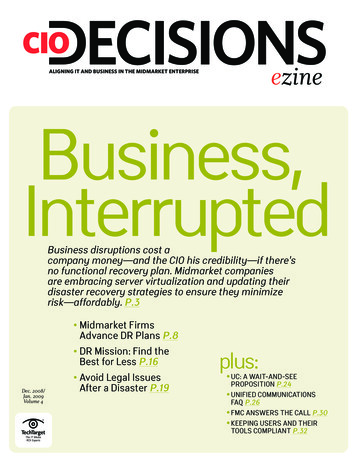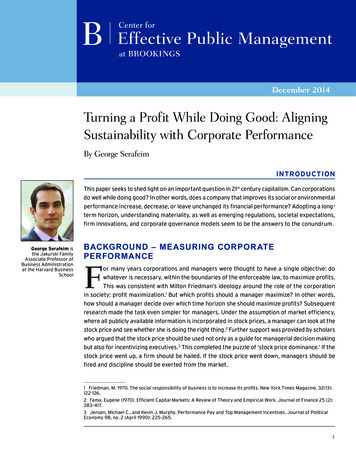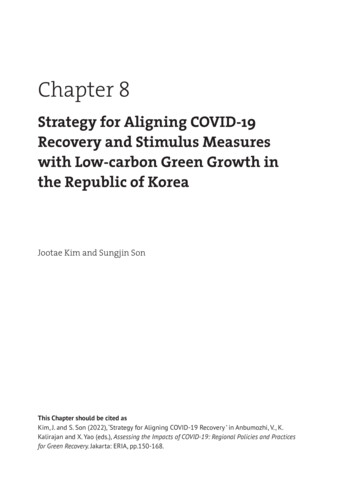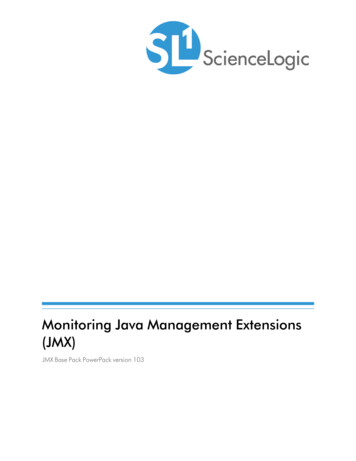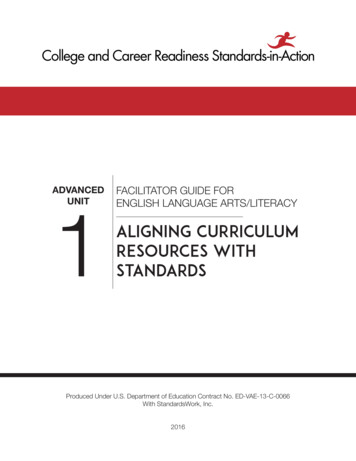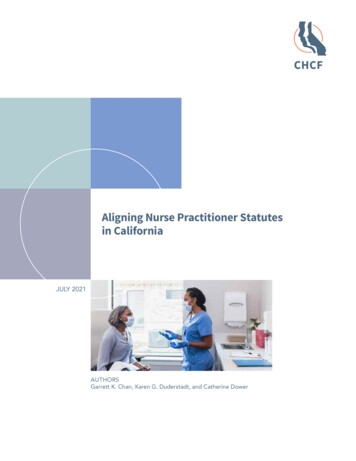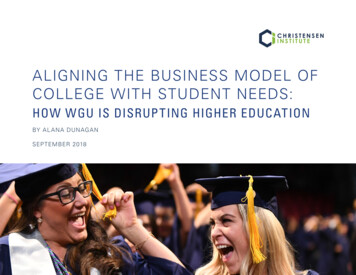
Transcription
ALIGNING THE BUSINESS MODEL OFCOLLEGE WITH STUDENT NEEDS:HOW WGU IS DISRUP TING HIGHER EDUCATIONBY AL ANA DUNAGANSEPTEMBER 2018
TABLE OF CONTENTSIntroduction3WGU’s business model4Value proposition: Student-obsessed5Resources: A college without classrooms—or professors5Processes: Designed to learn and evolve6Profit formula: Growing access and reducing costs7The disruptive elements of WGU’s approach10Technology10Innovative business model10Value network11Successful innovation12The freedom to start from scratch12Clarity around value proposition12Growth milestones and regulatory millstones13Conclusion14Notes15About the Institute19
INTRODUCTIONSince its inception, Western Governors University (WGU) has aimed to serve learners otherwise shut out ofthe traditional system. Now, the groundbreaking institution has both graduated 100,000 students and has over100,000 students currently enrolled. These milestones demonstrate WGU’s ability to scale its high-quality,low-cost model, signaling a momentous shift in the higher education landscape.In the mid-1990s, governors of 19 states across the western United Stateswere concerned about bringing accessible college education to ruralpopulations, especially working adults.1 These governors, led by UtahGovernor Mike Leavitt, decided to explore building a new university toaddress the challenge.2 As the memorandum of understanding betweenthose governors that officially marked the founding of WGU stated,“The strength and well-being of our states and the nation dependincreasingly on a strong higher education system that helps individualsadapt to our rapidly changing economy and society. States must lookto telecommunications and information technologies to provide greateraccess and choice to a population that increasingly must have affordableeducation and training opportunities and the certification of competencythroughout their lives.”3Now in its third decade, WGU has students in every U.S. state andhas over 100,000 enrolled students—a 230% increase since 2011. Thisgrowth is particularly notable given that overall higher educationenrollment has declined by over a million students since 2011—a declineconcentrated in the adult learner population. 4 But scale is not theschool’s only differentiator. Since its founding, WGU’s programs havebeen delivered entirely online, using a competency-based educationmodel that allows students to advance upon mastery. WGU’s mascotis the owl, in recognition that the majority of its students are ‘nightowls’—working and caring for their families during the day and pursuingtheir studies at night. 5 WGU students aren’t typical college attendees:the average WGU student is 37 years old, 74% are working full time, and40% are first-generation college attendees. 6WGU also employs a radically different staffing and instructional modelfrom most higher education institutions, and that model is achievingstrong results for students as seen in WGU’s data on graduation, jobplacement, earnings, student debt repayment, and satisfaction with theirWGU experience (see Figure 1).Figure 1. WGU vs. National DataWGUNational39%8Graduation Rate50%Time-to-Graduation2.5 years5.2 years9Percentage Employed96%91%Salary Increase10 21,200 12,000Debt Load 16,132 37,172Debt Default Rate4.6%11.5%Student Satisfaction1197%76%Source: All data for this table is from WGU 2017 annual report unless otherwise noted.7CHRISTENSEN INSTITUTE: WESTERN GOVERNORS UNIVERSIT Y3
WGU’S BUSINESS MODELWGU, designed as a competency-based institution from its founding,has a corresponding business model that is distinct from most otherinstitutions. All organizations—whether for-profit or nonprofit—have abusiness model, which is more than just the revenues and expensesthat define how an organization stays afloat financially.A business model includes four elements that determine what an organization can andcannot do: its resources, its processes, its value proposition, and its profit formula. Overtime, and especially as organizations become successful, the elements of the business modelbecome highly interdependent and resistant to change.4 Elements of a Business ModelFigure 2. Four elements of a business modelValue PropositionResourcesA specific promise tocustomers that a product orservice will enable them tosolve a problem in their lives.People, tech, facilities,equipment, and cashrequired to deliver a valueproposition totargeted customers.Profit FormulaProcessesAssets and fixed cost structurethat enable either profitabilityor, for nonprofits, long-termfiscal sustainability.Ways of working togetherto address recurrent tasksin a consistent way:training, manufactoring,budgeting, etc.CHRISTENSEN INSTITUTE: WESTERN GOVERNORS UNIVERSIT Y4
The potential of competency-based educationCompetency-based education is an approach to learning thatallows students to determine the pace of their learning andmove ahead once they demonstrate mastery in a concept. Asdescribed by Clayton Christensen and Michelle Weise:Competency-based programs have no time-basedunit. Learning is fixed, and time is variable; pacingis f lexible. Students cannot move on until theyhave demonstrated proficiency and mastery of eachcompetency but are encouraged to try as many times asnecessary to demonstrate their proficiency. Althoughskeptics may question the “rigor” behind an experiencethat allows students to keep trying until they havemastered a competency, this model is actually far morerigorous than the traditional model, as students arenot able to f lunk or get away with a merely averageunderstanding of the material; they must demonstratemastery—and therefore dedicated work toward gainingmastery—in any competency.12faculty desires, research activities, and donor concerns.15 Without acampus full of amenities to market to prospective students, WGU relieson demonstrating its value proposition by being transparent about thevalue it is creating for students.16Resources: A college withoutclassrooms—or professorsWGU offers programs across four industry areas: education, business,information technology, and healthcare. All of these programs are offeredonline; unlike most higher education institutions, WGU has no physicalcampus. Instead, it has invested heavily in a technology platform thatallows it to deliver curriculum asynchronously, to wherever students are.In addition to its online platform, another unique aspect of WGU’sresources is its approach to faculty. In traditional institutions, facultyare responsible for academic research, course development, teaching,assessment, and advising students. Alternatively, WGU’s modelunbundles the faculty role into component parts, with specialists ineach role.Competency-based education first took hold in the K-12education system, but it is also growing in higher education. Asof fall 2015, roughly 600 institutions were using or exploringcompetency-based programs in higher education.13 However,only a handful of institutions are using competency-basededucation exclusively and have designed their business modelsaround it.Value proposition: Student-obsessedPresident Scott Pulsipher describes the student as the core of theuniversity: “In everything we do, we put the student at the center ofit.”14 This contrasts with most other institutions that have a morecomplex business model in which student outcomes trade-off withIn an interview, President Pulsipher notes that WGU is not an attractivedestination for faculty who wish to be on a ‘stage’. Instead, WGU seeksto attract faculty who place student success far above research endeavorsor personal prestige. “If you fundamentally believe first and foremostin doing work and committing your life to changing the lives of others,then you will be well aligned to WGU,” Pulsipher says. “In a facultyrole, that means your success is about the success of your students,rather than advancing the theory or knowledge in the domain you’rein.”17 WGU has simplified the faculty role by eliminating traditionalrequirements, like publishing research, which do not directly advancestudent learning outcomes.WGU unbundles the traditional faculty role into four separate jobs (seeFigure 3):1. Program mentors are responsible for advising, coaching, andmentoring. They interact with students every week or two, andCHRISTENSEN INSTITUTE: WESTERN GOVERNORS UNIVERSIT Y5
more as needed, to ensure that students “understand expectationsand overcome obstacles to ensure success.”18 This role is importantgiven the typical profile of WGU students: working adults withmany demands on their time and many obstacles to completing theirdegrees. Continuity of mentorship is critical: more than 90% ofstudents graduate with the same mentor they had when they initiallyenrolled.2. Course instructors are subject-matter experts, typically with PhDs.Students can reach out to course instructors at any time to helpthem engage and understand concepts. Course instructors are alsoresponsible for proactively reaching out to students who seem to behaving trouble.3. Assessment & curriculum faculty design and develop assessment& curriculum and are responsible for iteratively improving them. Thisrole includes making decisions about which programs to launch, whatcourse materials to incorporate, and building the learning outcomesand competencies for each program.4. Evaluators are responsible for assessing whether students haveachieved mastery. They typically hold PhDs or terminal degrees intheir field, and to ensure a fair and unbiased evaluation process, haveno contact with students.19All of WGU’s curriculum materials are created outside of WGU;assessment & curriculum faculty are responsible for evaluating externalcurriculum and selecting which materials are the best fit for the learningobjectives of the course. At traditional institutions, faculty have thefreedom and responsibility to create a unique syllabus for every course—even when the same course is taught by multiple professors. Conversely,the WGU curriculum standardizes each course, so that students engagein the same coursework regardless of who their course instructor is,or when they start the course. This standardization reduces costs forWGU and allows WGU to systematically improve each course.A council of industry experts also advises each program area to tightenWGU’s curricular connections to the workforce and to ensure thatWGU is helping students demonstrate the competencies that are mostrelevant in the jobs they are likely to enter. 20Figure 3. Traditional staffing vs. WGU staffingTraditional Staffing ModelWGU Staffing ModelProgram MentorCourse InstructorTraditional FacultyMemberAssessment &Curriculum FacultyEvaluatorProcesses: Designed to learnand evolveWGU is focused on continuous improvement, informed by a constantstream of real-time data on student performance and progress.21Program mentors use this data to track the progress of individualstudents, and can proactively reach out to students who aren’t engagingwith coursework or making progress through competencies. Courseinstructors and assessment & curriculum faculty use aggregated studentdata to identify areas within the curriculum that can be improved.WGU takes advantage of the fact that it has a new cohort of 5,000students starting every month to continually test new approaches andCHRISTENSEN INSTITUTE: WESTERN GOVERNORS UNIVERSIT Y6
improvements to the curriculum, and rigorously measures the impact of these changes onstudent outcomes.For instance, based on insights that ‘soft skills’ correlate with long-term academic andprofessional success, WGU recently tested curriculum on leadership, self-management, andmotivation with a small group of students in the College of Health Professions. Thesestudents saw significantly improved engagement and retention, and based on those results,WGU quickly scaled the course to a much broader group of students. 22 To date, over 10,000nursing students have taken the course.Profit formula: Growing access andreducing costsWGU is a private nonprofit school; the states of the 19 governors who founded WGU eachprovided an initial 100,000 in funding, but WGU receives no state appropriations today.Thus, its revenues are almost entirely tuition-dependent—but over the last ten years WGUhas held undergraduate tuition more or less steady at just under 6,500 per year and hasdriven down student loan debt per graduate to less than half of the national average. 23Figure 4. Scaling enrollmentCHRISTENSEN INSTITUTE: WESTERN GOVERNORS UNIVERSIT Y7
Students at WGU pay tuition for each six-month term, rather thanpaying for each credit hour as in the traditional model. During eachterm, WGU students must complete a minimum of 12 competency unitsto demonstrate adequate academic progress—but there is no limit to howmany competencies they can complete. On average, WGU graduatescomplete bachelor’s degree programs in five terms, which dramaticallylowers the cost of a WGU degree. 24Even with lower costs, WGU has made a determined effort since 2013to reduce student debt borrowing through its Responsible BorrowingInitiatives program, lowering its student loan default rate to 4.6%,dramatically lower than the national average of 11.5%.25 This effort hasinvolved educating students about the full cost of debt, encouragingstudents to borrow only what they need, and has been complemented bya general cost consciousness across WGU that has kept overhead—andtherefore tuition—low.WGU’s instructional model and faculty model provide it with theflexibility to scale more quickly than traditional universities (seeFigure 4); WGU is growing enrollment over 20% annually. It has alsotaken advantage of more state-based partnerships to boost enrollment.Students in any state can attend WGU, but in certain states, WGUhas built what it refers to as a ‘state-affiliate’. In these states, leaderswanted to build an online, competency-based higher education optionthat is part of the state’s higher education system. Rather than startfrom scratch, they partnered with WGU. Partnership with WGU offersstates a no-cost way to expand access to higher education. 26In 2011, Indiana became the first state to partner with WGU, andother states quickly followed (see Figure 5). WGU now boasts affiliateprograms in eight states, which comprise nearly 40% of the school’s totalenrollment. The newest state-affiliate, Ohio, was formally approved inFebruary 2018 and officially launched in June 2018. 27Figure 5. Affiliate seeMissouriNevada2017North Carolina2018OhioCHRISTENSEN INSTITUTE: WESTERN GOVERNORS UNIVERSIT Y8
Figure 6.Traditional Business ModelA traditional business modelValue PropositionResourcesProvide traditional-agedstudents an all-inclusivecollege experiencePhysical campusFaculty-designed curriculumConsolidated faculty roleFocus on researchWGU’s business model hasenabled it to scale highquality education to over100,000 students, many ofwhom otherwise would nothave been able to access acollege education otherwise.Profit FormulaProcessesRelatively fixed enrollementFall start date predominatesHigh & escalating tuitionCredit hoursPay-per-creditTenureBundled services andexperiencesStudents sink or swimWGU’s BusinessModelWGU’sbusinessmodelValue PropositionResourcesDeliver high-quality online,competency-basededucation to working adultsacross the countryNo physical campusPurchased curriculumDecomposition of faculty roleFocus on mentorshipProfit FormulaProcessesFlat tuitionMonthly start datesPer-student costs lowAll-you-can-eat approachScalable instructional modelData-driven outreachPay-per-semesterRelationship focusCHRISTENSEN INSTITUTE: WESTERN GOVERNORS UNIVERSIT Y9
THE DISRUPTIVE ELEMENTS OF WGU’S APPROACHWGU’s business model has enabled it to scale high-quality education to over 100,000 students, many of whomotherwise would not have been able to access a college education.Fundamentally, a successful Disruptive Innovation has three elements:an enabling technology that makes a product more accessible to a widerpopulation; a business model that targets nonconsumers or low-endconsumers; and a coherent value network in which suppliers, partners,distributors, and customers are each better off when the DisruptiveInnovation succeeds.Disruptive Innovation (noun): a process by which a productor service (higher education) initially takes root in simpleapplications at the bottom of a market (adult learners)—typically by being less expensive and more accessible (lowertuition, online)—and then relentlessly moves upmarket(hitting 100,000 students), eventually displacing establishedcompetitors (traditional four-year institutions).TechnologyBreakthrough technology alone doesn’t make for a successful DisruptiveInnovation. Often, companies or organizations will adopt potentiallydisruptive technology and use it in the context of a traditional businessmodel. This has often been the case in higher education, in which onlinelearning is used in a traditional higher education model—expensive,exclusive, and targeted to the elite. 28WGU, on the other hand, has packaged the disruptive potential ofonline, competency-based education within the context of an innovativebusiness model, and has built a coherent value network around itsoffering. Online learning is a technological enabler for higher education,making college available to an increasing number of students who lackthe flexibility or wealth to attend an on-campus program.29 Onlinelearning has the potential—not always realized—to bend the cost curveof higher education, providing an education with far lower fixed coststhan a physical campus, and lower variable costs than the traditionalsage-on-the-stage model.WGU’s programs follow this trajectory. They are exclusively online.This delivery model has lowered costs, enabling WGU to reachnonconsumers—the working adults that the school was designed toserve. Online technology has also made it possible for WGU to layer insignificant supports, including mentorship and course instructors whoprovide readily available academic assistance.Innovative business modelOnline education, and even competency-based education, can beemployed within the context of a traditional business model. Butat WGU, the entire business model—value proposition, resources,processes, and profit formula—reflect an organization that is designeddifferently from traditional higher education.WGU’s value proposition targets working adults, rather than the 18to 24-year-old full-time students who are the traditional customers ofhigher education. A WGU education is designed to help its studentsadvance in the workforce. In keeping with this value proposition, allof WGU’s majors are designed to align with specific jobs, and eachprogram is designed to ensure that students are learning the skills andcompetencies they will need to succeed in the workforce.CHRISTENSEN INSTITUTE: WESTERN GOVERNORS UNIVERSIT Y10
In designing around the needs of these nontraditional students, WGUhas created new processes, scaffolding both academic and nonacademicsupports to help students succeed. While this adds some cost to themodel, WGU avoids the costs of some traditional higher educationactivities, like research and building curricula from scratch, that don’tdirectly add value to students.WGU’s resource base—its employees, physical footprint, technology, andfinancial resources—are optimized to fit its disruptive value propositionWGU doesn’t have a physical campus, instead heavily relying on asophisticated technological infrastructure to power its programs. 30Online delivery enables working adults, who often lack the flexibilityto attend rigid brick-and-mortar programs, to successfully access college.WGU invests in employees, such as mentors, that most traditionalhigher education institutions don’t have, while eschewing the traditionalprofessor role that dominates the instructional model at most schools.Focusing on mentors provides more support where learners need it most,while ensuring that students have the academic resources they need.The profit formula at WGU is also entirely different from that of mostinstitutions. Ten years ago, WGU’s 6,000 annual tuition was similar tothe typical four-year public school. But today, WGU’s tuition is under 6,500, and the average public university has raised tuition by more than60 percent. 31 And, unlike most public colleges, WGU receives no stateappropriations. It has been able to keep its tuition low by streamliningits activities to those that add value for students, and by using its scalablemodel to reach more students.Value networkFor any college, the value network incorporates students and employers.For many, it also includes federal and state governments, whichcontribute significant revenues to higher education. The value networkalso includes publishers, curriculum developers, and outsourced serviceproviders.Critics of online education often point to abuses in the for-profitsector, in which some schools have used the technology to provide alow-quality education that has left students with weak employmentprospects and mountains of debt. Regulators have cracked down onfor-profits as a result; innovation in higher education that doesn’t createvalue for students isn’t sustainable and can never be successful as aDisruptive Innovation. 32Innovation that doesn’t create valuefor students isn’t sustainable and cannever be a successfulDisruptive Innovation.On the other hand, WGU has made student outcomes the cornerstoneof its value proposition, measuring student employment gains andsatisfaction. In a recent Gallup survey, 72% of WGU students stronglyagreed that their education was worth the cost, relative to only 37%of graduates nationally. 33 WGU graduates were much more likely torecommend the WGU experience to friends or coworkers. 34 WGU’s lowstudent debt default rates also demonstrate that WGU is creating valuefor students.The state affiliate model is another example of a win-win across thevalue network, in which WGU’s success creates value for others as well.States, hungry to improve their economic competitiveness, but frustratedwith the cost of higher education, are eager to partner with WGU’slow cost, workforce-aligned model. 35 Demand from states can motivategovernors and other state leaders, despite pushback from establishedhigher education institutions that may see WGU as a threat. 36CHRISTENSEN INSTITUTE: WESTERN GOVERNORS UNIVERSIT Y11
SUCCESSFUL INNOVATIONWGU’s disruptive approach has been wildly successful, but not widelyreplicated. Disruptive Innovations are often ignored by incumbents,and when traditional players do try to adopt a disruptive strategy,they often find it to be challenging or even impossible. Considering ahigher education industry that is seeing declining enrollment, financialstruggles, and increasingly unaffordable tuition, what has enabled WGUto move along an entirely different trajectory, providing a low-cost,high-quality education aligned to the needs of the workforce?The freedom to start from scratchCritically, WGU has had the same value proposition since its founding. It has built itsbusiness model, including its data-driven and student-obsessed culture, instructional model,and profit formula around that value proposition from the beginning. As WGU has foundsuccess, its business model has coalesced.The traditional business model is under significant pressure, as parents, students, and statesstruggle to afford the cost of college. While many schools are staying the course and hopingthat high-end, high-cost innovations can help them compete successfully, only a handfulare attempting to employ a disruptive strategy. Traditional schools will struggle to replicateWGU’s success without building an entirely autonomous unit, and giving that unit thefreedom to build a new business model centered on a new value proposition, just as WGUhas done. 37Critically, WGU has had thesame value proposition sinceits founding: prepare studentsfor the workforce.Clarity around value propositionThe business model of a traditional college is highly complex. It interweaves knowledgecreation (research activities) with knowledge transmission (educational activities), andprofessors are often responsible for both. Colleges are expected to create value not just fortheir students, but also for society broadly in the form of new knowledge, as well as for thecommunities in which they reside through economic activity. 38 This complexity has costs andmakes traditional institutions unwieldy and difficult to manage. 39CHRISTENSEN INSTITUTE: WESTERN GOVERNORS UNIVERSIT Y12
WGU, on the other hand, has cut through this complexity. As PresidentPulsipher said, “To some degree, you have to ask the question: ‘Whatis the primary purpose of the institution?’ Are you designed to produceknowledge or to transfer knowledge? That drives all other institutionalchoices.”40 WGU is clear about its purpose: it wants to transfer knowledgeto students to help them be successful in the workforce. That clarity israre in higher education, and helps WGU avoid or eliminate activitiesthat don’t directly relate to its purpose.and financial aid disbursements linked to ‘credit hours’ which definededucation in units time (i.e. hours and semesters) rather than metricsaround learning, such as competencies. The regulatory framework forcedWGU into bureaucratic gymnastics to demonstrate that its programs fitrequirements for federal financial aid programs.WGU’s story demonstrates thepotential of Disruptive Innovation tobroaden access, lower the cost ofcollege, and align with the needs ofthe workforce.In fall 2017, the Office of the Inspector General of the U.S. Departmentof Education (OIG) had completed an audit of WGU and ruled thatdespite achieving strong student outcomes, WGU had run afoul ofthese regulations. WGU argued that it provided 24/7 access to courseinstructors and required weekly interaction with program mentors.However, the OIG countered that WGU’s deconstructed faculty modeldid not fit the definition of instructor, which the law did not define. Itrecommended that WGU be required to return 713 million in federalfinancial aid funds—the largest fine in the history of the department.Growth milestones andregulatory millstonesWGU has reached a tremendous milestone: 100,000 students enrolled.Its story demonstrates the potential of Disruptive Innovation in highereducation to broaden access, lower the cost of college, and align withthe needs of the workforce. But it also shows the barriers that DisruptiveInnovations need to overcome.WGU has struggled to fit into a regulatory framework designed foranother era. The federal law that governed higher education, the HigherEducation Act (HEA), made no mention of competency-based education,The HEA’s rules governing online programs were even more problematic.Written in 1992, the language defining ‘distance education’ aimed todescribe institutions who sent coursework to students through the mailin the 1980’s. To be eligible for federal financial aid programs, the HEArequired distance education providers to ensure students had “regularand substantive interaction with instructors.”The Secretary of the Department of Education, Betsy DeVos, is expectedto overturn the OIG’s ruling, and in the interim WGU is continuing toconduct business as usual. 41 The audit tells far more about the challengesin regulating innovation—and the difficulties of fitting innovative modelsinto existing regulations 42 —than it does about any wrongdoing or deficitat WGU. Such challenges are typical for Disruptive Innovations, whichoften fit like a square peg in a round regulatory hole.In many other industries, Disruptive Innovations have reshapedregulatory frameworks—but only after they are successful. WGU’s modelmay be following a similar path: recent proposals to reform the HigherEducation Act show support for eliminating regulations that havebedeviled WGU. 43 But regulatory change isn’t the key to WGU’s growth;in fact, it is WGU’s success in creating value for students that will be thekey factor in driving regulatory change.CHRISTENSEN INSTITUTE: WESTERN GOVERNORS UNIVERSIT Y13
CONCLUSIONDisruptive Innovations enter the market at the low end—but theydon’t stay there forever. Enabled by technology, they grow and moveupmarket. WGU’s data-driven focus on self-improvement has steadilyimproved the quality of its offering, as demonstrated by a range ofmetrics, including student satisfaction, retention, and graduation rates.Disruptive Innovations often change the nature of industry competition, defining newdimensions of performance that matter to the market. In WGU’s case, workforce alignmentis a critical new dimension of performance. WGU’s programs are designed with workforceoutcomes in mind, ensuring that students are learning the skills they will need to succeed inthe workforce—something that is often left to chance in traditional programs. 44WGU illustrates the potential of disruptive models to scale high-quality education to thestudents who need it most. Since its founding, WGU has pioneered new approaches, newtechnologies, and new business models, all with the aim of bringing high-quality educationto underserved populations. Today, it serves 100,000 students from all 50 states, boastingstrong outcomes and low costs. WGU is a textbook definition of a Disruptive Innovation: ithas paired technology with an innovative business model—and has built a value network thatcreates win-wins for students, employees, states, and the workforce.CHRISTENSEN INSTITUTE: WESTERN GOVERNORS UNIVERSIT Y14
NOTES1 “The governors recognized that many college graduates had skills thatwere unreliable and insufficient to meet the future needs for a highlyskilled workforce. Traditionally, underserved students who are minority,rural, low income, or the first generation in their family to attend collegestruggle to navigate complex higher education and financial aid syst
strong results for students as seen in WGU's data on graduation, job placement, earnings, student debt repayment, and satisfaction with their WGU experience (see Figure 1). Figure 1. WGU vs. National Data National Source: All data for this table is from WGU 2017 annual report unless otherwise noted.7 WGU Graduation Rate Time-to-Graduation



